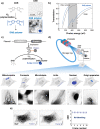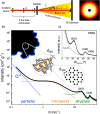X-ray-Based Techniques to Study the Nano-Bio Interface
- PMID: 33650433
- PMCID: PMC7992135
- DOI: 10.1021/acsnano.0c09563
X-ray-Based Techniques to Study the Nano-Bio Interface
Abstract
X-ray-based analytics are routinely applied in many fields, including physics, chemistry, materials science, and engineering. The full potential of such techniques in the life sciences and medicine, however, has not yet been fully exploited. We highlight current and upcoming advances in this direction. We describe different X-ray-based methodologies (including those performed at synchrotron light sources and X-ray free-electron lasers) and their potentials for application to investigate the nano-bio interface. The discussion is predominantly guided by asking how such methods could better help to understand and to improve nanoparticle-based drug delivery, though the concepts also apply to nano-bio interactions in general. We discuss current limitations and how they might be overcome, particularly for future use in vivo.
Keywords: X-ray techniques; degradation; delivery; imaging; nanoparticles; nano−bio interface; spectroscopy; synchrotron radiation.
Conflict of interest statement
The authors declare no competing financial interest.
Figures





















Similar articles
-
Synchrotron radiation techniques boost the research in bone tissue engineering.Acta Biomater. 2019 Apr 15;89:33-46. doi: 10.1016/j.actbio.2019.03.031. Epub 2019 Mar 15. Acta Biomater. 2019. PMID: 30880235
-
Medical applications of synchrotron radiation x-rays.Phys Med Biol. 1997 Jul;42(7):1213-43. doi: 10.1088/0031-9155/42/7/001. Phys Med Biol. 1997. PMID: 9253036 Review.
-
Macromolecular structures probed by combining single-shot free-electron laser diffraction with synchrotron coherent X-ray imaging.Nat Commun. 2014 May 2;5:3798. doi: 10.1038/ncomms4798. Nat Commun. 2014. PMID: 24786694
-
Micropipette aspiration as a tool for single-particle X-ray imaging and diffraction.J Synchrotron Radiat. 2023 Jul 1;30(Pt 4):788-795. doi: 10.1107/S1600577523003685. Epub 2023 May 26. J Synchrotron Radiat. 2023. PMID: 37233735 Free PMC article.
-
Bio-metals imaging and speciation in cells using proton and synchrotron radiation X-ray microspectroscopy.J R Soc Interface. 2009 Oct 6;6 Suppl 5(Suppl 5):S649-58. doi: 10.1098/rsif.2009.0166.focus. Epub 2009 Jul 15. J R Soc Interface. 2009. PMID: 19605403 Free PMC article. Review.
Cited by
-
A Comparative Study of Ultrasmall Calcium Carbonate Nanoparticles for Targeting and Imaging Atherosclerotic Plaque.ACS Nano. 2023 Jul 25;17(14):13811-13825. doi: 10.1021/acsnano.3c03523. Epub 2023 Jul 3. ACS Nano. 2023. PMID: 37399106 Free PMC article.
-
Imaging tools for plant nanobiotechnology.Front Genome Ed. 2022 Dec 8;4:1029944. doi: 10.3389/fgeed.2022.1029944. eCollection 2022. Front Genome Ed. 2022. PMID: 36569338 Free PMC article. Review.
-
Enabling X-ray fluorescence imaging for in vivo immune cell tracking.Sci Rep. 2023 Jul 17;13(1):11505. doi: 10.1038/s41598-023-38536-5. Sci Rep. 2023. PMID: 37460665 Free PMC article.
-
X-ray Fluorescence Uptake Measurement of Functionalized Gold Nanoparticles in Tumor Cell Microsamples.Int J Mol Sci. 2021 Apr 1;22(7):3691. doi: 10.3390/ijms22073691. Int J Mol Sci. 2021. PMID: 33916283 Free PMC article.
-
Feasibility of Monitoring Tumor Response by Tracking Nanoparticle-Labelled T Cells Using X-ray Fluorescence Imaging-A Numerical Study.Int J Mol Sci. 2021 Aug 14;22(16):8736. doi: 10.3390/ijms22168736. Int J Mol Sci. 2021. PMID: 34445443 Free PMC article.
References
Publication types
MeSH terms
LinkOut - more resources
Full Text Sources
Other Literature Sources

